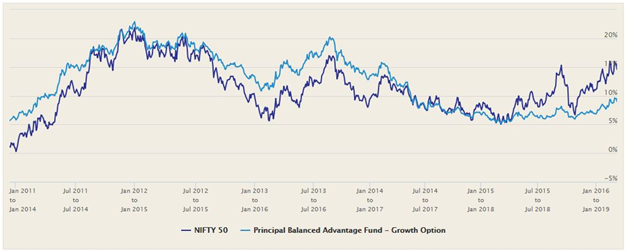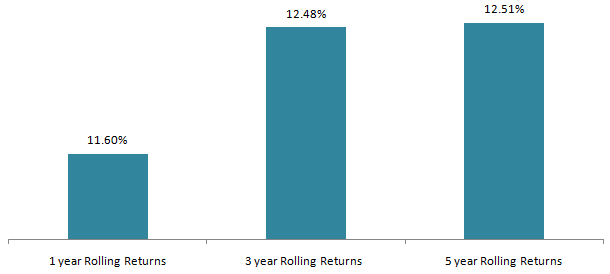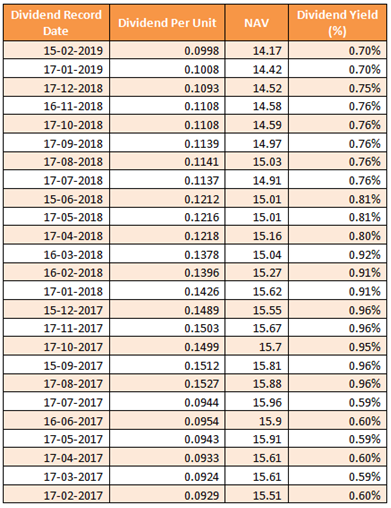Principal Balanced Advantage Fund: Good investment option in uncertain market conditions

What are Balanced Advantage Funds?
Balanced Advantage Funds dynamically rebalance their asset allocation between equity and fixed income (debt) based on stock market valuations based on a dynamic asset allocation model. If equity valuations are low, then in dynamic asset allocation the model will increase asset allocation to equity and correspondingly decrease (in percentage terms) asset allocation to fixed income (debt). If equity valuations are high, then the model will shift in asset allocation from equity to fixed income to get a higher percentage of debt allocation in their portfolio. Balanced Advantage Funds essentially sell stocks (book profits) and buy bonds in up markets and vice versa in down markets, in other words, buy low and sell high. The rebalancing is done on a regular basis and this reduces the risk profile of the investment as market goes up. Consequently when the market falls, the downside risk is limited.
Principal Balanced Advantage Fund
Principal Balanced Advantage Fund works on the dynamic asset allocation strategy described above. The dynamic asset allocation model of the fund defines valuation (Price to Equity Ratio) bands and corresponding asset allocation ranges for each band. PE bands work better than absolute PE levels because it gives the fund managers the latitude of managing asset allocation changes within the band, reduces impact cost of sudden asset allocation changes and reduce volatility of returns. The fund has given 9% annualized returns since inception and nearly 11% annualized returns in the last 5 years.
The fund was launched in 2010. Its expense ratio is 2.68%. P.V.K Mohan and Beckxy Kuriakose are the fund managers of this hybrid scheme. The chart below shows the NAV movement of the fund over the last 5 years.

Source: Advisorkhoj Research
Rolling Returns
The chart below shows the three year rolling returns of Principal Balanced Advantage Fund since inception.

Source: Advisorkhoj Research
Investors should notice how downside risks are limited over 3 year investment tenor in Principal Balanced Advantage Fund. The minimum 3 year rolling returns is 5.2%. The average 3 year rolling return is 12.5%, while the median 3 year rolling return is 13%. The maximum 3 year rolling return is 23%. This shows that, the fund had enabled investors, over a sufficiently long investment tenor, to capture the upside potential, while limiting downside risks.
How Principal Balanced Advantage Fund provided stability to investors
The table below shows the 5 worst monthly periods of Nifty 50 and corresponding returns of Principal Balanced Advantage Fund.

Source: Advisorkhoj Research
Notice how downside risk in volatile markets was protected by the fund. When the market (Nifty) fell 10 to 15%, the fund fell only 2 – 6.5%.
Average rolling returns
The chart below shows the annualized average rolling returns of the fund for various rolling return periods (holding periods). You can see that over long investment tenure the average rolling returns are higher. Therefore, long investment tenures are recommended for this fund.

Source: Advisorkhoj Research
Probability distribution of returns
Assuming normal distribution (bell curve) of returns, we have estimated probabilities of different rates of returns based on 3 year monthly rolling returns of Principal Balanced Advantage Fund. For our quantitatively inclined readers, probability distribution of returns can be calculated using average, standard deviations and normal distribution table. Investors should understand that probabilities represent likelihoods and there is no assurance of returns in mutual funds. Let us now see the likelihood of different return scenarios for 3 year investment holding periods.

Source: Advisorkhoj Research
You can see that probability of getting 12%+ returns is around 53%, while probability of getting 8 to 10%+ returns is around 70 to 80%. You can also see that probability of getting 15%+ return is around 30%. Investors should not expect very high returns in balanced advantage funds, but the probability of getting returns higher than fixed income is quite high.
Let us now see the likelihood of getting different returns for 5 year investment holding periods from Principal Balanced Advantage Fund.

Source: Advisorkhoj Research
You can see that probability of getting more than 12% returns increases to 65% over 5 year investment tenors. There is near certainty (97% likelihood) of getting double digit returns. This reinforces our point that Balanced Advantage Funds, if you have a long investment tenor, then these funds are good investment choices compared to fixed income from a risk return trade-off standpoint.
Dividend Track Record
Principal Balanced Advantage Fund has a strong dividend payout track record. For the last 2 years, the fund has been paying regular monthly dividends. Average monthly dividend yield over the last one year or so has been around 0.8% - nearly 10% on annual basis.

Source: Advisorkhoj Research
Tax Advantage
One of the biggest benefits of Balanced Advantage Funds is that they enjoy equity taxation – short term capital gains (investment held for less than 12 months) are taxed at 15%, while long term capital gains (investment held for more than 12 months) up to Rs 1 lakh are tax free – long term capital gains in excess of Rs 1 lakh are taxed at 10%. Dividends paid by Balanced Advantage Funds are tax free in the hands of the investor, but the fund house has to pay 10% dividend distribution tax (DDT).
Conclusion
In this post, we discussed how Principal Balanced Advantage Fund works. We also discussed at length how the fund limits downside risks for investors through its dynamic asset allocation strategy. This makes the fund good investment option for investors with moderate to moderately aggressive risk appetites. In our view, investors should have long investment horizon to get the best returns from this fund. Investors should consult with their financial advisors if Principal Balanced Advantage Fund is suitable for their investment needs.
Mutual Fund Investments are subject to market risk, read all scheme related documents carefully.
Queries
-
What is the benefit of mutual fund STP
Aug 29, 2019
-
How much to invest to meet target amount of Rs 2 Crores
Aug 26, 2019
-
Can I achieve my financial goals with my current mutual fund investments
Aug 24, 2019
-
Can you tell me return of various indices
Aug 19, 2019
-
What would be the post tax return on different investments
Aug 18, 2019
-
Which Principal Mutual Fund scheme will be suitable for my retirement corpus
Aug 16, 2019
-
What is the minimum holding period for availing NCD interest
Aug 4, 2019
Top Performing Mutual Funds
Recommended Reading
Fund News
-
Zerodha Mutual Fund launches Zerodha Nifty Short Duration G Sec Index Fund
Dec 26, 2025 by Advisorkhoj Team
-
Groww Mutual Fund launches Groww Nifty Chemicals ETF
Dec 26, 2025 by Advisorkhoj Team
-
DSP Mutual Fund launches DSP Nifty Next 50 ETF
Dec 19, 2025 by Advisorkhoj Team
-
DSP Mutual Fund launches DSP Nifty 500 Index Fund
Dec 19, 2025 by Advisorkhoj Team
-
Kotak Mahindra Mutual Fund launches Kotak Nifty Next 50 ETF
Dec 18, 2025 by Advisorkhoj Team














